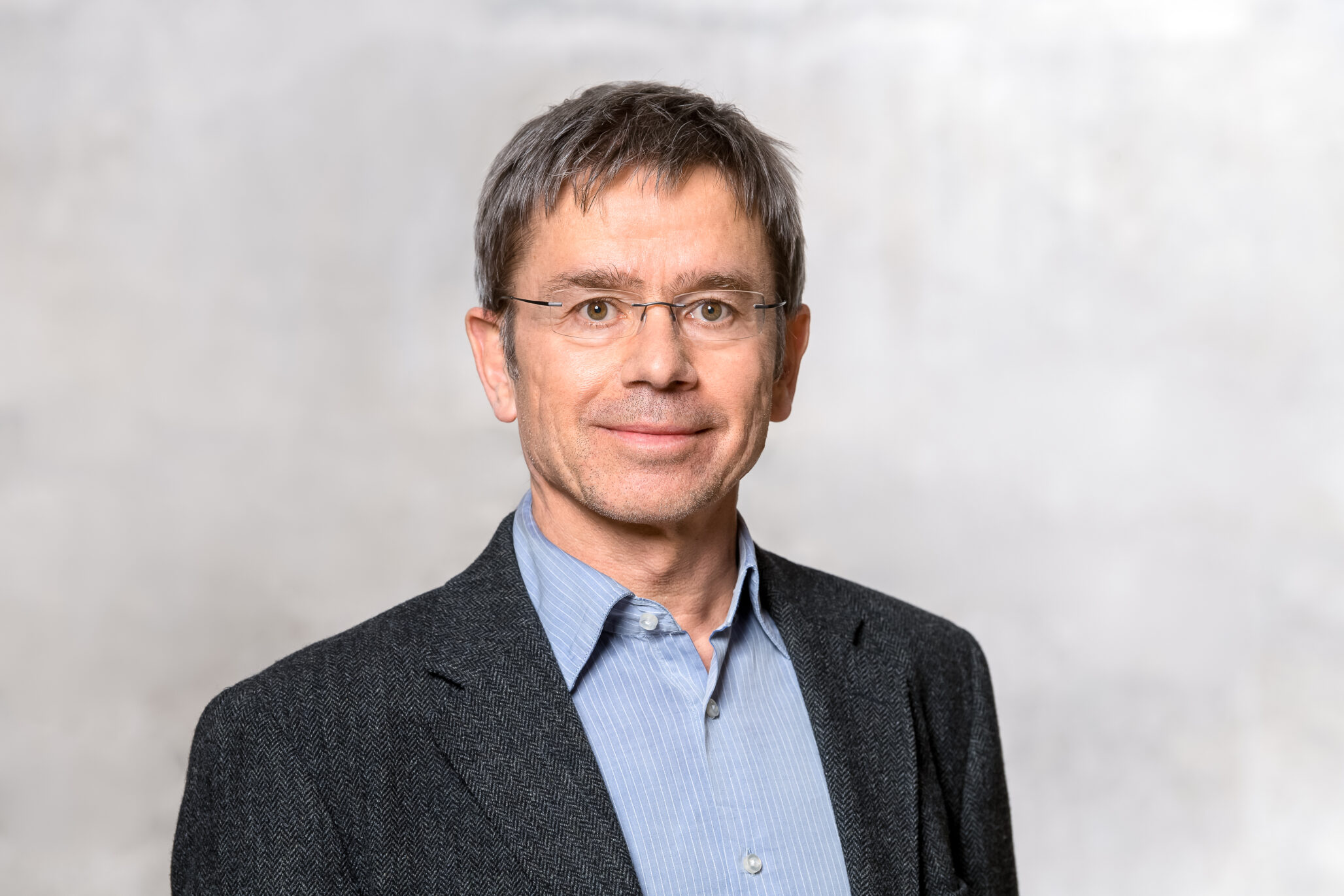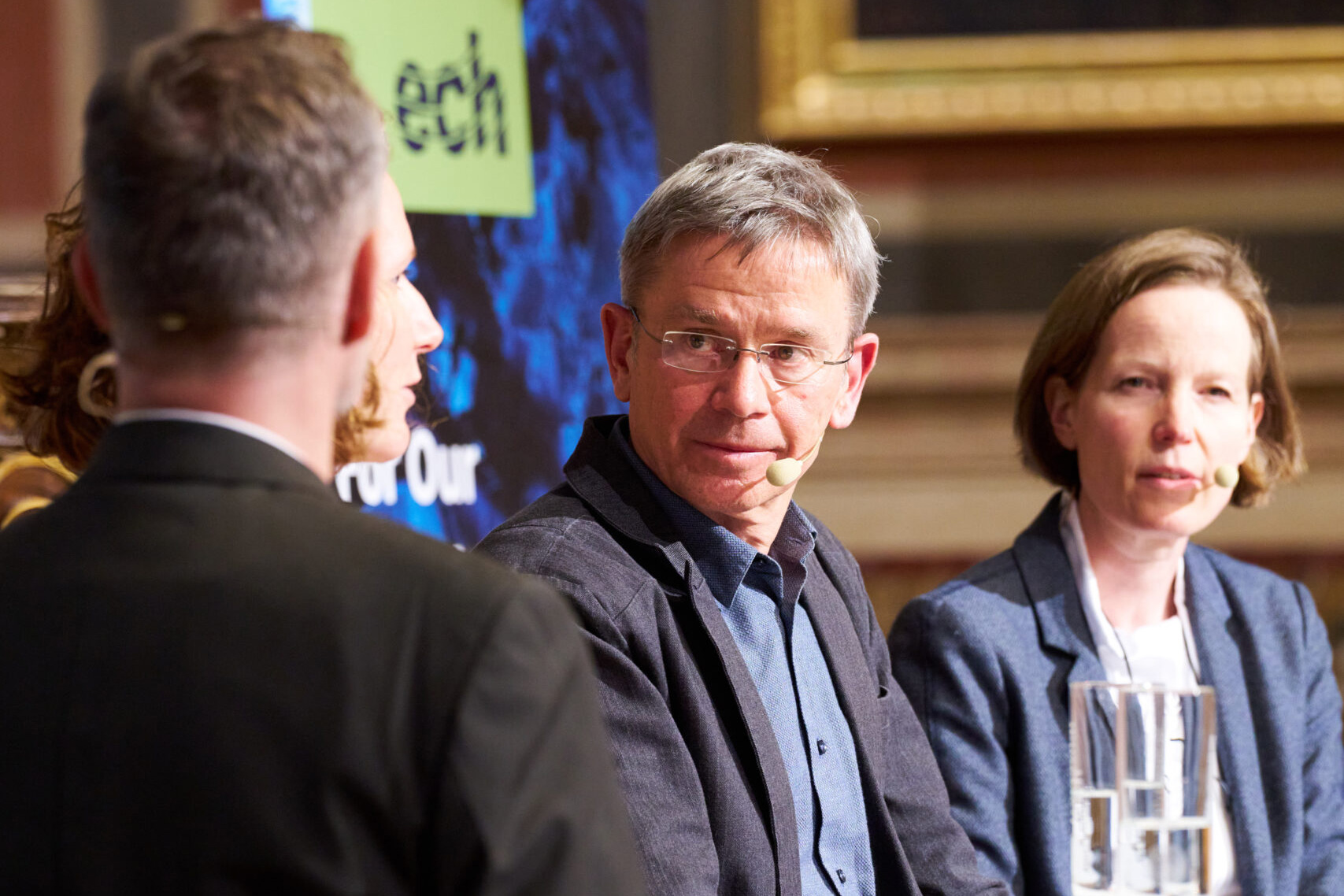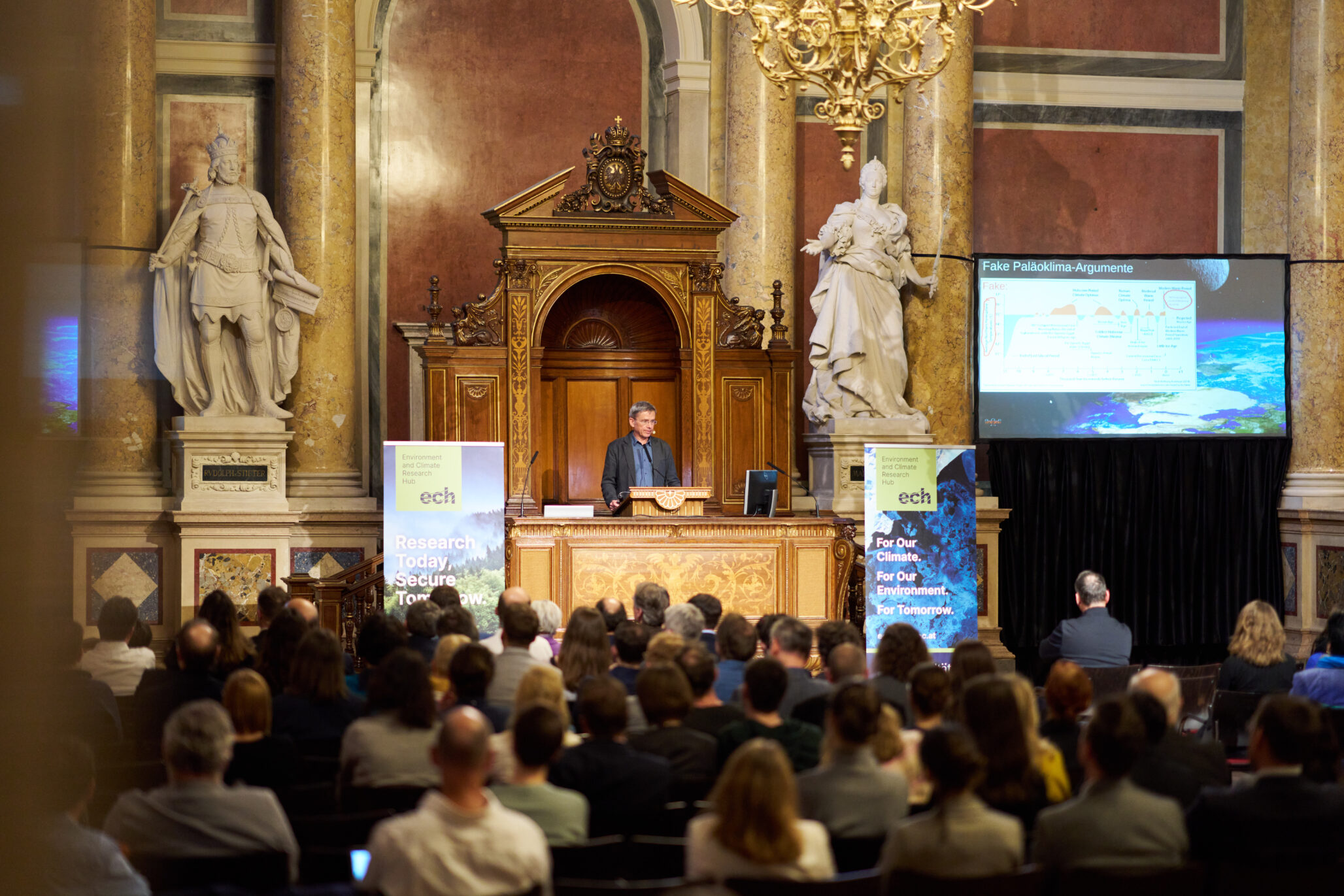Climate researcher Stefan Rahmstorf spoke about “The climate debate – between science, the Querdenker (lateral thinkers) movement and populists” in his keynote speech at the kick-off event of the Research Network Environment and Climate on 8 March.
Nora Gau (head of the ECH editorial team) met Stefan Rahmstorf for an interview after his keynote speech.
ECH editorial team: Stefan Rahmstorf, you are one of the most renowned climatologists and due to your research you are one of the world’s leading oceanographers and palaeoclimatologists. You first studied physics and then physical oceanography. When did your enthusiasm for your research topic begin?
Stefan Rahmstorf: Very early, actually: I grew up in Holland, and the North Sea awakened my enthusiasm for the sea. Later, when I was studying physics, I realised that it was also possible to use physics to conduct marine research. In fact, it was one book in particular that fascinated and interested me, “The Drama of the Oceans”, written in 1975 by the maritime lawyer and ecologist Elisabeth Mann Borgese. When I read it, I thought, “Wow, that is actually a great research topic”, and then I started studying physical oceanography at the University of Wales in Bangor.
ECH editorial team: As a palaeoclimate researcher, you study the climatic conditions of the Earth’s past in order to make predictions about the future development of the climate on our planet. What can we learn from the ice age?
Stefan Rahmstorf: The past major climate changes that the Earth experienced over millions of years help us to understand how and, above all, how strongly our climate has responded to perturbations so far. The most important lesson we can learn from this for our future is the so-called climate sensitivity, the reaction to known perturbations in the Earth’s radiation balance. Climate sensitivity tells us the extent to which the global temperature responds to changes, for example, how much warming is caused by a doubling of CO2. The answer is about three degrees. This was first calculated at the end of the 19th century by the Swedish Nobel Prize laureate Svante Arrhenius. At the time, he calculated a warming of four degrees.
Today we know that the result is between two-and-a-half and four degrees, which is the range of uncertainty we still have. The fact that the climate has always reacted strongly to disturbances in the radiation balance in the past is a lesson from the ice age. And then there are other lessons, such as about the instability of ocean circulation. This is the background to the concern that the circulation of the Atlantic could break off, because this has happened several times in the Earth’s history, for example when temperatures on Earth warmed after the last ice age.
ECH editorial team: You raise an issue that is currently hyped in the media: The possible collapse of the Atlantic Meridional Overturning Circulation (AMOC), which is of great importance for the relatively mild temperatures in Europe, has been a constant topic in the media in recent months. As an oceanographer, you have been researching this topic for some time: Can this collapse still be stopped? If not, when would we feel the effects around the world?
Stefan Rahmstorf: When we talk about the consequences, we are talking about what will happen when we have passed the tipping point. But we do not yet know when and if global warming will reach that point. What is clear, however, is that from that point onwards, the dynamics would run their course within a few decades.
However, we could minimise this risk if we consistently abide by the Paris Agreement and keep global warming well below two degrees.
ECH editorial team: And what happens if we pass the so-called tipping point and the current stops?
Stefan Rahmstorf: If the AMOC were to collapse, the effects would indeed be fatal: there would be strong regional cooling, not only over the ocean, but also over land areas in north-western Europe. According to a new study by the Utrecht University, which has just been published in the media, the Norwegian coast could be 20 to 30 degrees colder in winter.
But that is by no means the only consequence. The tropical rain belts would shift southwards. These rain belts would then no longer fit over the rainforests, where they actually belong. As a consequence, some forests would dry out or burn down, while there would be heavy rainfall in regions where people are not adapted to it.
Another problem is that the ocean’s uptake of oxygen and CO2 would be greatly reduced if the AMOC were to collapse. This is because it is driven by water that sinks to depths of 3,000 metres. If this stops, the deep ocean will be deprived of oxygen. This would disrupt the marine ecosystem, with consequences we cannot yet foresee.
And here in Europe? Since the temperature gradients across Europe would change massively, it would be much colder in Scandinavia and, due to the CO2, much warmer in Spain. And it is these temperature differences that drive weather patterns.
Fotos © www.markuskorenjak.com
ECH editorial team: In your keynote speech you say that all reputable scientists agree that modern global warming is around 100 per cent anthropogenic, i.e. caused by humans. However, this fact does not seem to have gone down well with the public, with polls showing that many people still believe that 30 per cent of scientists disagree. Why is that?
Stefan Rahmstorf: One reason is the lobbying of fossil fuel companies and some multi-billionaires who fund the so-called climate sceptics, their appearances and publications. Rupert Murdoch, for example, uses his media empire to promote statements by climate sceptics that are intended to raise doubt. But I also see a problem with other media that try to be balanced: they keep putting sceptics on talk shows, even though they have no scientific expertise, and then pretend that they are broadcasting a scientific debate. But in reality, the debate on the media is one between the interests of lobbyists and serious science. It is a distorted and confusing debate for the public.
ECH editorial team: You criticise the fact that politicians and society continue to delay solutions to the climate problem – what do you think are the reasons for this?
Stefan Rahmstorf: This is also due to lobbying. But even here there has been a shift in recent years: The lobbyists know that they can no longer prevent the protection of the climate because its implementation has been agreed by virtually all countries in the Paris Agreement on climate change of 2016. But now their goal is to keep making money from the fossil fuel business model for as long as possible, and they are doing everything they can to delay action and solutions. Most politicians are not brave enough to stand up for unpopular measures because it could cost them votes. And then, of course, there are parties that deliberately exploit this and, for example, demonise the climate minister in Germany because he passed a heating law according to which 65 % of new heating systems must be powered by renewable energy in the future. Such measures are simply necessary if we want to achieve climate neutrality. But it is then so scandalised – also by some of the media – that politicians are afraid to implement it.
ECH editorial team: As you say, it is always an interplay between politics and the media, which actually have the power to change things and shake up the public. But it is not easy for us journalists to report on climate change because many people do not want to hear about it anymore.
What would be your recommended strategy to reach people? Would you rather report on positive solutions to create a good atmosphere, or would you put the hard facts on the table?
Stefan Rahmstorf: I do not think it is an either/or question. Of course, you should report on the facts and the state of scientific research – without glossing over anything. But it is also important to discuss solutions more intensively. That is what I have wanted for decades. Fortunately, we are now at that point. But even here you can see that lobbyists are pushing a lot of false narratives: Electric cars are supposedly worse for the climate than combustion engines, or such nonsense. The lobbying activities of the climate sceptics have shifted from denying climate change itself to making the solutions look bad.
ECH editorial team: In your opinion, is it also up to scientists to make their voices heard in politics?
Stefan Rahmstorf: It is definitely the job of scientists to warn of dangers. After all, I also expect a doctor to tell me, “If you continue to smoke, your risk of lung cancer will increase”. And we scientists have to communicate in the same way: We have evidence that if we continue to emit CO2, it will get warmer, which will lead to rising sea levels and extreme weather events with all their consequences. As scientists, we are paid by the public and should act in the public interest. It is therefore our duty to educate and warn – as scientists and as citizens.
ECH editorial team: You are publicly presenting your research findings. Why is this exchange so important for you?
Stefan Rahmstorf: On the one hand, even as a schoolboy and student I benefited a lot from popular science presentations in books or magazines. At that time, the enthusiasm for science simply gripped me. And I want to pass on this enthusiasm for science and research. But of course, I also want to inform people about the dangers and warn them about the consequences.
ECH editorial team: To what extent is interdisciplinarity, as practised at the Research Network Environment and Climate, particularly important in climate issues?
Stefan Rahmstorf: Interdisciplinarity is extremely important because climate change is not a specialised problem of just one discipline. The consequences ultimately affect our entire life world: politics, health, cities, traffic planning, etc. In order to find solutions, we need to work in an interdisciplinary way. Our Institute, the Potsdam Institute for Climate Impact Research, was founded in 1992 with this in mind. We have been doing this for decades, ranging from basic research on the mechanisms of ocean circulation to the development of concrete proposals for policy-makers, such as how to draw up climate legislation. So I can only congratulate the University of Vienna on the establishment of the interdisciplinary Climate and Environment Research Network, because it builds a bridge between science and the public. And that is exactly what we need in the fight against populism and disinformation on climate issues.
ECH editorial team: Stefan Rahmstorf, thank you very much for this interview.

About Stefan Rahmstorf
Stefan Rahmstorf has been conducting research on climate change and its consequences for more than 30 years. He is climatologist and oceanographer and is head of the Earth System Analysis research department at the Potsdam Institute for Climate Impact Research. He has been Professor of Physics of the Oceans since 2000. His research focuses on paleoclimate, changes in ocean circulation and the sea level as well as extreme weather events. Rahmstorf often addresses the topic of global warming in public lectures as a keynote speaker or in the RealClimate blog, which he co-founded.




